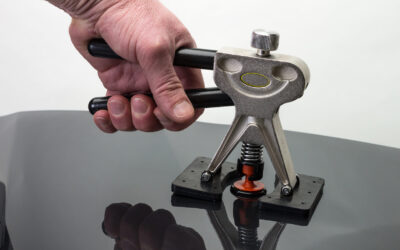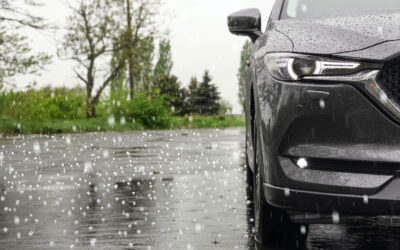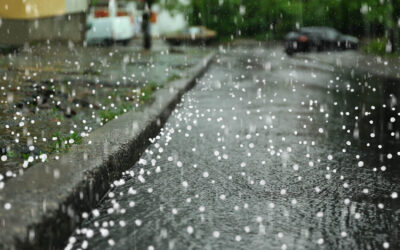When it comes to hail damage repair, size definitely matters. Different hailstone sizes cause different types of dents, dings, and cracks — and knowing the difference can save you time, money, and stress. While professionals deal with these distinctions every day, it’s helpful for vehicle owners to understand how hail size impacts repair needs and times, as well as insurance costs.
Nowhere is this more true than in Denver, which sits right in the heart of “Hail Alley.” Local drivers know all too well how fast a sunny day can turn into a storm with golf-ball-sized hailstones. These common hailstone encounters leave lasting marks on vehicles. That’s why paintless dent removal in Denver by Mile High Dents has become the go-to solution for repairing hail damage quickly and affordably.
In this guide, we’ll walk through the different sizes of hail, the kind of damage each can cause, and what to expect when it comes to repairs.
You’ve Driven Through a Denver Hail Storm and Your Car Is Covered in Dents
Anyone driving in Colorado is eight times more likely to have hail damage to their vehicle than in other parts of the country, and Colorado ranks second in the U.S. for hail insurance claims. This guide is for the many Colorado drivers who encounter hailstorms.
- Denver drivers caught in storm season who want to understand what hail size means for their vehicles.
- Car owners with newer models (2018 and up) who need to know when hail damage is worth repairing versus when insurers may total the car.
- Busy families and professionals who don’t have time for a long, complicated repair process and want a stress-free, insurance-friendly solution.
- Anyone considering paintless dent removal in Denver who wants to learn why PDR is the preferred choice for hail damage.
Hail Size Damage Chart (At-a-Glance)
Not all hailstones are created equal. Making note of the size of the hailstones can give you a good idea of what type of damage to expect — and whether repairs will be minor or extensive.
| Hail Size | Comparable Object | Typical Car Damage |
| ¼” | Pea Sized | Often minimal; minor dings possible on hoods/roofs |
| ½” – 1” | Marble/Quarter (most common hail size in Denver) | Visible dents and paint damage more likely |
| 1.5” | Golf Ball | Deep dents, cracked paint, possible glass/mirror damage |
| 2.5+” | Baseball | Severe dents, shattered glass, potential total loss |
What Each Hail Size Means for Your Car
Drive long enough in Colorado and you’ll see just about every size hail there is, but knowing how to deal with it is challenging, as we can see in the hailstone descriptions below:
Pea-Sized Hail (¼ inch)
At first glance, pea-sized hailstones don’t look threatening. These tiny, cloudy ice pellets often bounce off without leaving apparent damage. But don’t be fooled — even small hail can create shallow dings on flat surfaces like hoods and roofs, especially if the storm lasts a long time or the hail is driven by strong winds.
Pea-sized hail may only cause cosmetic blemishes on newer cars. Older vehicles with thinner metal may have more noticeable impressions. These dents can be hard to spot in standard lighting, but may show up under bright sunlight or when washing your car.
While pea-sized hail rarely cracks paint or glass, it can still reduce your car’s resale value. If you suspect damage, a quick inspection by a paintless dent repair specialist in Denver is worth it.
Quarter-Sized Hail (1 inch)
Once hail reaches quarter-size, visible damage will be apparent. This is the threshold at which insurance claims spike across Colorado. Quarter-sized hail can create multiple dents across your vehicle’s hood, roof, and trunk; sometimes, it can chip or crack the paint.
Paint damage is more than just appearance — once paint is compromised, moisture can seep in, leading to rust and long-term structural issues. That’s why prompt repair is important.
Denver drivers often assume minor dents aren’t worth fixing, but cumulative damage from a single storm can quickly reduce your car’s value by thousands. Also, minor dents and dings that aren’t repaired can graduate into chipped paint, which will require a new paint job to restore your vehicle, which is more expensive and devalues your resale value.
Golf Ball Hail (1.5 inches)
Golf ball-sized hail is where things get serious. The impact of a 1.5-inch ice stone falling at high speed can leave dozens of deep dents across a vehicle. Unlike smaller hail, golf-ball hail often affects not just horizontal surfaces but also side panels, doors, and fenders.
This size makes cracked paint common, and mirrors, headlights, or even windows may break. If your car was parked outdoors during a storm like this, it’s almost certain you’ll need professional repairs. You’ll almost certainly need professional body repairs to restore the panels, roof, or hood.
The good news? Most insurance company policies cover hail of this size under comprehensive coverage. Most modern auto body shops work directly with insurers to streamline the process, so you don’t get stuck navigating claims alone.
Baseball Hail (2.5 inches and up)
Baseball-sized hail is rare, but it’s devastating when it happens. These massive ice stones can weigh several ounces and hit with enough force to shatter windshields, dent roofs beyond repair, and even cause structural damage to a vehicle’s frame.
When hail reaches this size, insurers often declare cars a total loss because the cost of repairs exceeds the vehicle’s value. For newer vehicles, that can mean a frustrating replacement process.
If your car seems intact, hidden damage is possible. Glass may have micro-cracks, and panels can weaken under heavy impacts. That’s why a professional inspection is critical after a severe storm.
Denver has seen billion-dollar hail events fueled by baseball-sized stones. If you’re unlucky enough to get caught in one, you’ll need expert repair advice to evaluate whether repair is possible — and handle the insurance conversations for you.
Hailstone Sizes and Car Damage
Whether it’s pea-sized hailstones leaving tiny dings or large golf-ball hail causing serious dents, size matters when protecting your vehicle. In Denver’s Hail Alley, even “average” storms often bring quarter-sized hail — the most common culprit behind insurance claims. Knowing what to expect helps you act quickly, file a claim, and choose the correct repair method before small problems turn into bigger ones.
Hail Storm Damage Repair Services in Denver
Living in Hail Alley means Denver drivers face more severe hailstorms than anywhere else in North America. If your vehicle has been caught in a storm, don’t wait to get it checked.
At Mile High Dents, we specialize in premium hail dent repair, including paintless dent repair. You can get a free quote or book an appointment, and our hail damage specialists will carefully evaluate your vehicle to recommend the best repair options.
Would you prefer to discuss it on the phone? Call us at (720) 772-0133 during business hours. Our team is ready to answer your questions and help you schedule a visit.
At Mile High Dents, we specialize in paintless dent repair (PDR) for all types of vehicles across the Denver metro area. Whether you’re dealing with hail damage, an annoying door ding, or a larger dent, our expert technicians restore your vehicle to like-new condition without repainting, sanding, or fillers.





